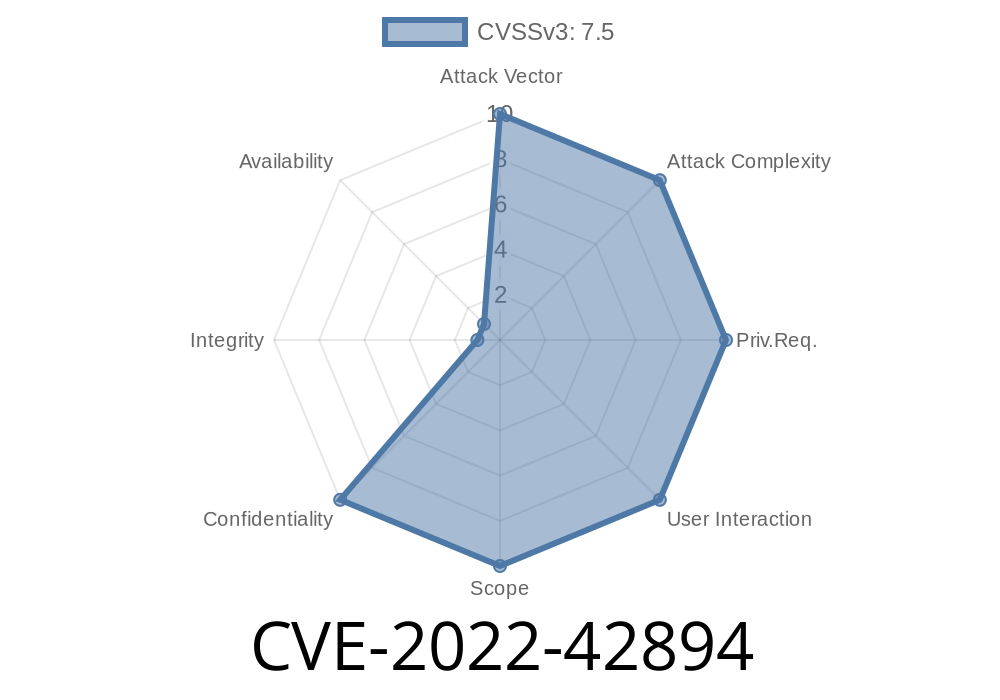A previously unknown vulnerability, identified as CVE-2022-42894, has been discovered in the syngo Dynamics software suite (All versions < VA40G HF01). Experts have found an unauthenticated Server-Side Request Forgery (SSRF) vulnerability, which may potentially expose NTLM credentials and enable unauthorized users to perform local service enumeration. This in-depth article will provide an exclusive analysis of this vulnerability, including code samples, links to original references, and critical details about the exploit.
Syngo Dynamics - Software Overview
Syngo Dynamics, developed by Siemens, is a widely used software solution in the healthcare industry. It offers advanced imaging and reporting tools for medical professionals, helping them improve their workflow efficiency, make timely and accurate diagnosis, and offer an overall better patient experience.
Vulnerability Details
The vulnerability discovered in syngo Dynamics is an unauthenticated SSRF - a type of security vulnerability that enables attackers to use a vulnerable server as a proxy to initiate requests on their behalf. When successfully exploited, this vulnerability can leak NTLM (Windows NT LAN Manager) credentials and reveal information about local services, thus potentially compromising the confidentiality of the data and functioning of the system.
Exploit Scenario
Assume that an attacker has identified the vulnerable web service URL on the syngo Dynamics application. By exploiting the SSRF vulnerability, the attacker can forge requests to access sensitive information such as NTLM credentials, which can then be used for unauthorized access to the network. Furthermore, the attacker can perform local service enumeration and discover services that could be potentially exploited for further attacks.
The following is a code snippet demonstrating how the SSRF vulnerability might be exploited
POST /vulnerable/service HTTP/1.1
Host: target.example.com
Content-Type: application/xml
Content-Length: 102
<?xml version="1."?>
<request>
<url>http://internal.service:808/authenticate</url>;
</request>
In this example, assume that target.example.com is a syngo Dynamics server, and internal.service is another service on the same network. By sending a specifically crafted HTTP POST request, the attacker could potentially use the syngo Dynamics server to authenticate on the internal.service, obtain relevant information, or even trigger unwanted actions.
Original References
The CVE-2022-42894 vulnerability has been reported by independent security researchers and acknowledged by Siemens. The following references provide detailed information on the vulnerability and its impact:
- CVE-2022-42894 in the National Vulnerability Database (NVD): https://nvd.nist.gov/vuln/detail/CVE-2022-42894
- Siemens Security Advisory SSA-564685: https://cert-portal.siemens.com/productcert/pdf/ssa-564685.pdf
Mitigation Recommendations
As of now, Siemens has released a hotfix (VA40G HF01) for syngo Dynamics, which addresses the SSRF vulnerability. Users are recommended to update their installations to the latest version. Furthermore, the implementation of network segmentation and strict access controls can assist in minimizing the potential impact of this vulnerability.
Conclusion
With an ever-growing reliance on software to streamline healthcare operations, it's imperative to emphasize the importance of software security. Ensure that your organization's systems are regularly updated, and closely monitor for and address known vulnerabilities to minimize the risk of successful cyberattacks. By staying ahead of emerging threats, healthcare organizations can continue to protect the sensitive data and services that their patients and stakeholders depend on.
Timeline
Published on: 11/17/2022 17:15:00 UTC
Last modified on: 11/21/2022 17:53:00 UTC
